Bust Bat Drag With Camwood Heavy Bat? Baseball & Softball Hitting Drills To Get Rid Of, Cure, And Fix Causes Of Racing Back Elbow
Bust bat drag with Camwood heavy bat? Simple baseball and softball hitting mechanical drill to help get rid of, cure, and fix causes of racing back elbow. I probably wouldn’t look to fixing bat drag with a heavy bat like Camwood in the beginning. It’s mainly caused by a mechanical and over-rotation issue.
Baseball Hitting Drills For Little League: How To Fix Bat Drag In 2-Weeks [Swing Experiment]

Look at my 11u hitter Jace’s racing back elbow, and the fix a week later. On the left side, he weighed in at 68-lbs, and right before our session, hit his first official homer distancing 180-feet!
Question: Does ‘Top Hand Finger Pressure’ Effect Bat & Hand Speed, and Time To Impact versus Keeping the Hands Loose? (Pre-Turn Hand Tension Revisited)
Using the Zepp (Labs) Baseball app, I wanted to use the Scientific Method to revisit a past experiment I did titled “Babe Ruth Reveals Hand Tension?” And analyze whether having relaxed hands OR ‘finger pressure’ affects Zepp metrics.
Growing up, I was taught baseball hitting drills for Little League – which are still being taught, that loose hands are quick hands. Modern research REVEALS that may not be the WHOLE story.
I wanted to revisit the previous ‘Babe Ruth experiment’ because in that test, I wasn’t actively holding the finger pressure through impact. In this experiment, I will be.
In the Conclusion of this post, I’ll also give a couple examples of my hitters who were suffering from really stubborn bat drag (one for over 1.5 years), and how we used ‘finger pressure’ to correct it within 1-2 weeks.
SCIENCE-BASED TRAINING:
Improve your hitting strategy dramatically by applying human movement principles.
Learn not only how and what to train but also the science behind the methods.
Background Research
In the Babe Ruth Pre-Turn Hand Tension Zepp swing experiment, I used the following Research links:
- Pavel Tsatsouline Tim Ferriss podcast revealing how the hands can be used to recruit more muscle tissue and connect larger areas of the body,
- Homer Kelly’s book The Golfing Machine
went into describing one of the four power accumulators in the golf swing, and
- Thomas Myers’s book Anatomy Trains
, and how Front Arm Fascial Lines are responsible for connecting what an explosive rotational athlete is holding in their hand(s), with the other springy fascial lines inter-weaving throughout the rest of the torso and body.
I also wanted to point out that a few months after publishing the ‘Babe Ruth Pre-Turn Hand Tension’ experiment I met Lee Comeaux, now a good friend of mine, who is a professional golf instructor out in Texas. He’s been studying Thomas Myers’s book Anatomy Trains for over a decade now.
He simplifies the concept we now call top hand finger pressure. So THANK YOU Lee! CLICK HERE to visit Lee’s (Roy) YouTube channel. And by the way, Lee has a 13u daughter playing fastpitch softball in Texas, and last time I heard she was hitting .800 using the same principles we talk about here.
So yes, this works for both fastpitch and baseball hitters!
Please watch the following interview with Thomas Myers titled, “Tensegrity Applied To Human Biomechanics”:
- Defining tension & compression Forces (0:10)
- Applying tension to the structure makes it stronger and more stable (5:55)
- Applying tensegrity to the human body and tightening up as a benefit to taking on impact (12:35)
I’ve also heard Thomas Myers talk about synovial fluid in our joints. It’s our lubrication system. And it’s liquid, between the joints, when we’re relaxed…in the above video, he called this “adaptability”.
However, when we catch a ball in a glove, for instance, we squeeze our hand around the ball turning the synovial fluid to a solid state. This concept becomes important when we’re talking about ‘finger pressure’ when hitting.
I tell my hitters it’s the difference between the ball feeling like it’s hitting a cinder block (the bat), or a wet pool noodle.
Hypothesis
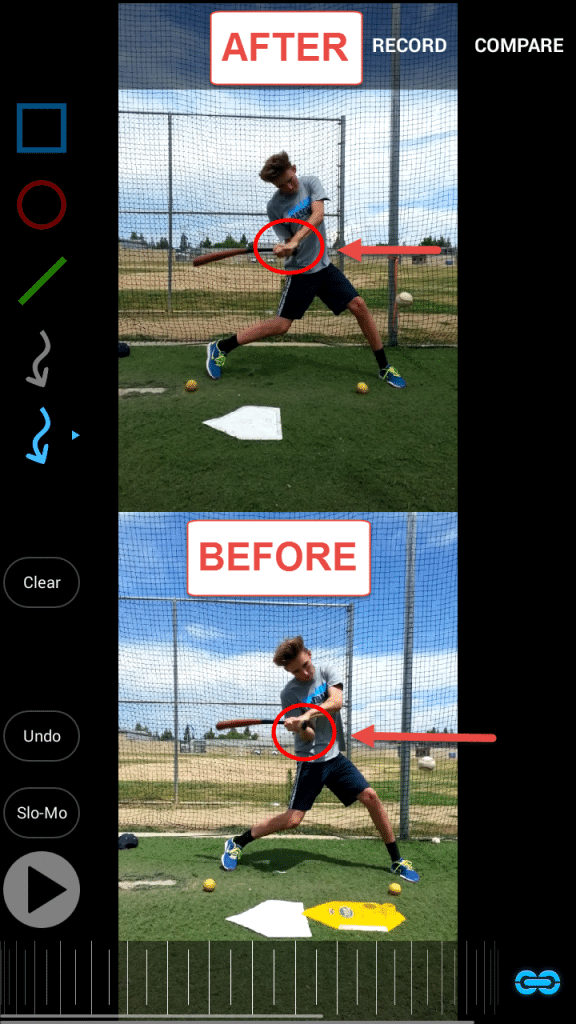
This is my Sophomore in H.S. Zack and his racing back elbow BEFORE & AFTER. This was a 1 week fix employing ‘finger pressure’.
I’m a little biased in this experiment because I’ve seen the research AND how this has worked miracles with my own hitters employing ‘top hand finger pressure’. However, I wanted to conduct another formal experiment comparing the following Zepp metrics:
- Bat Speed at Impact,
- Hand Speed Max,
- Time To Impact,
- Barrel Vertical Angle at Impact, and
- Attack Angle…
…between the two swings. Whereas the aforementioned ‘Babe Ruth Pre-Turn Hand Tension‘ experiment I held the hand tension before the turn, then let it go. This experiment I’ll be keeping top hand finger pressure from the moment I pick up my front foot to stride, to all the way through impact.
I predict, by using ‘top hand finger pressure’ longer, we’ll see an effective jump in all metrics rather than the conventional of ‘loose hands are fast hands’. I also predict holding finger pressure longer will be more effective than the previously mentioned experiment metrics for Pre-Turn Hand Tension.
At the end, I’ll show how ‘finger pressure’ has STOPPED bat drag in two of my hitters at the Conclusion of the experiment.
Baseball Hitting Drills For Little League: ‘Finger Pressure’ Experiment
Equipment Used:
- Backspin Batting Tee,
- Zepp Labs Baseball app
- Flip Camera
,
- My Android GS6 phone camera,
- Baseballs, and
- 33-inch BBB Bamboo wood bat
Setup:
- We used the Zepp Labs Baseball app to gain swing data.
- I stayed as consistent as I could with keeping the ball height and depth the same for most swings.
- I used two yellow dimple ball markers to make my stance setup consistent…one was placed inside my back foot, close to the plate. The other was placed one bat’s length plus two baseballs in front of the back marker.
- The two tests in the baseball hitting drills for Little League ‘finger pressure’ experiment were counter-balanced. Which consisted of eight blocks of 25-swings done in the following order ABBA BAAB. ‘Finger pressure’ was letter ‘A’, and ‘loose hands’ was letter ‘B’. 200 total swings were completed in the experiment, 100 per test. Counter-balancing helps remove the “getting tired” and “not being sufficiently warmed up” factors.
- On the finger pressure swings, I used top hand bottom three finger pressure only, which consisted of tightening up the top hand bottom three fingers (pinky, ring, & middle) from the time I picked my stride foot up, to all the way through impact. The bottom hand was doing what I call the ‘butterfly grip’…tight enough to keep a butterfly from getting away but not too tight to crush it.
- Loose hands consisted of trying to maintain a ‘butterfly grip’ throughout the whole swing.
- Throughout the baseball hitting drills for Little League swing experiment, I was drinking a Lime Cucumber flavored “Pepino” Gatorade (very good btw) and a chocolate milk to replenish my body’s protein, sugars, and electrolytes during the 2-hour experiment.
- I did an 8 exercise dynamic warm up in this baseball hitting drills for Little League experiment before taking about 15-20 practice swings off the tee.
Data Collected (Zepp App Screenshot)
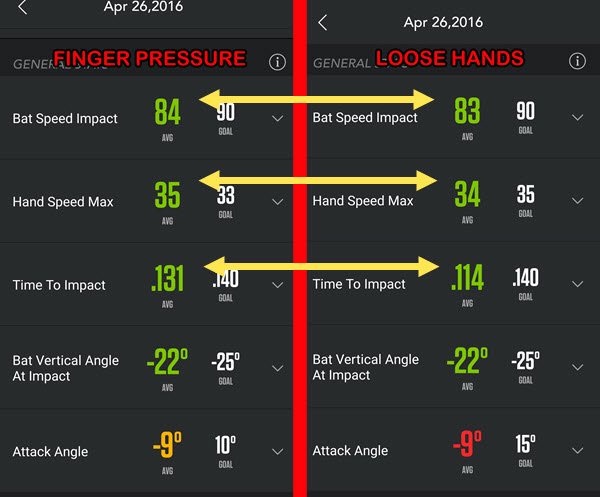
Notice the slight change in bat and hand speed metrics, AND the difference in Time To Impact…
Data Analysis & Conclusion
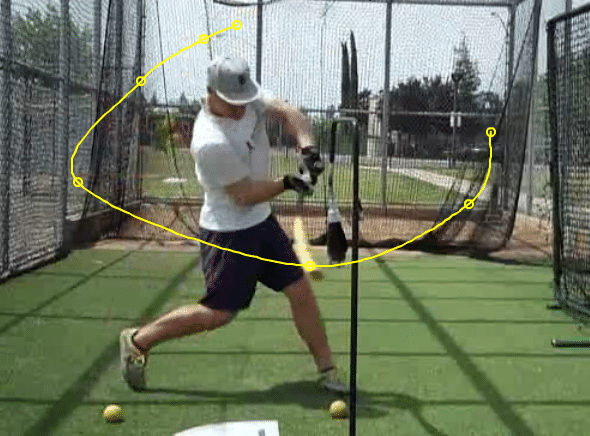
You can clearly see the negative Attack Angle. This was a finger pressure swing.
- Using ‘Finger Pressure’ gained an average of 1-mph Bat Speed at Impact
- Using ‘Finger Pressure’ gained an average of 1-mph Hand Speed Max
- Using ‘Loose Hands’ decreased Time To Impact by a whopping 0.017 (17/100th’s of a second)
- Bat Vertical Angle & Attack Angle showed no differences between the two swings.
These were interesting findings in this baseball hitting drills for Little League finger pressure Zepp swing experiment.
My Hypothesis proved correct in that we saw an increase in average Bat Speed at Impact and Hand Speed Max employing ‘finger pressure’, however it wasn’t a huge change.
Also in my Hypothesis, this experiment didn’t turn out more effective for finger pressure than it did for Pre-Turn Hand Tension (PTHT) in the Babe Ruth Experiment, where I gained an average of 3-mph Bat Speed at Impact using PTHT.
You’ll notice the major decrease in Time To Impact using the ‘loose hands’ method. Excluding the racing back elbow bat drag hitter, from these results and the Thomas Myers research, we can say using a hybrid of the two methods…loose hands at the start of the turn, and finger pressure slightly pre-, at-, and post- impact would be more effective than not.
On the contrary, for the bat drag hitter with a racing back elbow issue, I think finger pressure MUST be used before the turn happens because these hitters evidently have a ‘fascial connection’ issue between what they’re holding in their hand, and their turning torso.
In other words, they may not intuitively use finger pressure like other hitters without the racing back elbow issue. So this would be one of the smarter baseball hitting drills for little league.
Besides, according to the Zepp app Time To Impact Goals for Pro hitters are right around .140 anyway, so my .131 with finger pressure is still more effective.
One last thing to note, coming from my experiential knowledge in working with my hitters, I consistently see a 2-3-mph boost in Ball Exit Speed when using finger pressure versus NOT in one 45-minute session.
This just means I’ll have to REVISIT this baseball hitting drills for Little League finger pressure Zepp swing experiment again, but collecting and comparing Ball Exit Speed data.
If you have any other thoughts or questions about this baseball hitting drills for Little League Zepp swing experiment, please respond below in the comments…THANKS in advance!
- Fix Late Swings Fast: 2025 Pitch Recognition & See-Decide-Swing Training for Youth Baseball Power Hitters - October 6, 2025
- Safe Youth Weighted Bat Training: Proven Overload/Underload Drills to Increase Exit Velocity in Games Starting Tonight - September 29, 2025
- AI Coaching Course 2025: Youth Baseball & Softball Practice Plan + Off-Season & In-Season Workout Builder Fast - September 23, 2025

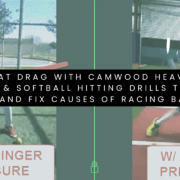
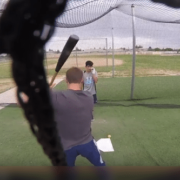

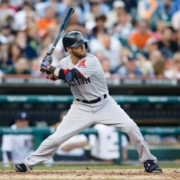


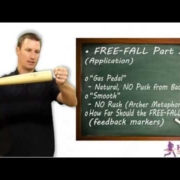




Interesting read, Joey. Is the top hand finger pressure with the bottom 3 fingers only?
Also – looks like your swing is improving… your Zepp data is way better than in the older experiment! 🙂
Yes Matt, top hand bottom three fingers only. Thanks for noticing my swing improvement…I think it’s because I started resistance training again – it’s been over 3 years since. I’m about 3 weeks into training, so that I assume is the improvement. The glaring issue though is my Attack Angle, which got really bad since last experiment.
Are you coming to the dark side with bottom hand pressure… As we know one arm rotates and the other folds… The way I look at it is… We get strong or as you call it… Hit with a steel beam…. And then there’s a timer, sort off… But it’s all related together… With one hand holding the bat and the other swinging … But that’s feel… Well and real… Depending on how you look at it. The hands -both- do pulling, pushing, squeezing turning and everything in between… But I think we LET most and focus on a few forces. And the armpits and forefinger area triggers pushing ( back swing -on plane) and fforward swing…… At the end you Hold and Turn… And if you understand Hold and Turn… Than it seems like you get that steel beam and turn into the ball… So bat speed can be misleading… And certain physics can make it misleading… You want the steel beam at top bat speed…Not top bat speed… And I think… We need some bottom hand pressures… In order to get top bat speed while having that steel beam… And you want that top bat speed because your steel beam seems like it’s timed… And you also want to control the making of the steel beam and releasing it along with that top bat speed while hsving the steel beam… And bottom hand pressures are needed… If I’m wrong… Oops… And if you don’t know connection you most likly think I’m from Mars…
So… Make a steel beam and turn fast… Use your “stride” to turn faster and to increase your ability to adjust… Oops we don’t need “strides”….Just like we don’t need to turn faster or we don’t need to make adjustments …I’ve been told lately “we don’t need striding”….
I was like… “Really… Wow… You must be really strong and good… Really good…I need to “stride”…. Or else I would have a hard time squaring a ball” especially with force…and also if I don’t “stride”… I feel like I have to guess earlier to pitch plane…
I hate the term “stride” and “plane” in baseball…
For me striding is so important… In my order… 1) adjustments and 2) momentum… For some reason some don’t like striding and some who don’t know there making adjustments… I’m wondering if they are not using bottom hand pressures…
Need is a funny word…?
I’m out… Hope all is well…
~DM
Yes, this one definitely made me think. We have to ask quality questions to get quality answers. Most will say who cares, ‘finger pressure’ v. ‘loose hands’ or a combination of the two, BUT these small details can make a big difference. As Thomas Myers says, the whole body is connected…if you stand there, extend your right hand out to your side, and rotate your torso to get that arm behind you while keeping your feet stationary…what are you’re feet doing? You’ve shifted your foot pressure to the inside of the left foot and outside of the right foot. This is a good example of how what the arm does, affects what the feet do.
I remember a long long time ago someone talking about foot pressures and someone saying it was interesting… And will look into it…I think I added some substance… Funny!
A little, hey, you… That person with that stick, not bad!!! Or not… At the least whatever you do…don’t ask me if I played pro… ?
It’s hard enough that everyone at the sports complex looks at me like I’m from Mars… Especially, since my son was scared for a long long time…, your right about results… You mentioned that before… About long run… And sticky coaching..,My son started feeling comfortable 5 weeks ago… And I didn’t do anything with him for 2 years except NOT say anything…… Maybe a few things…But No pressure… Have fun.. He’s 8.,,I feel like I know one or two things… No need to force the issue but I do think fasica has some good memory buts that another story…So I’ve been giving him lessons for 5 weeks And now he’s hitting very well… Very well…
And now everyone is like what did you do differently… And I’m thinking should I say… I’m Just telling him to make this steel beam that this dude out in California talks about and than turn fast ?…. And a little 3 figure salute… Alright I use to be cool… Now I’m far far away living in the suburbs trying to be funny…
Hope all is well…
I’m out!
~DM
How about using the lead hand trigger… Forefinger area… Hold it tight and use your back elbow and shoulder joint ( back arm pit) to get you rear side going… Try pushing that lead hand trigger for the back swing at different times of the back arm pit action… ( back elbow or show #) .. Action… I feel different type of turns… Add bottom and hand and more finger pressure diversity and I find interesting results… I feel like I can hold the steel beam and get it to the ball faster…I’m not ever thinking… Level, down,up…pull, push, bat speed, hands, throwing the barrel, stride, lead foot, back foot, about a bug, knee action… Im thinking… Twist or twirl, squeeze, Hold, hold, see ball, Go and turn than compress ball…apparently from Mars…?
Can I add observation…you set up… Shoulders around and elbows in….And fold behind you… Fingers pressure ls up…Tip behind and down to the ground… Than hold the bottom hand index-thumb ( bottom hand cupped)…and twirl load starting with bottom pinkie… Hold the rest of the bottom hand and do bottom 3 and thumb from top hand… You should feel the bottom hand pressure… Than pressure should make it easy to feel the turn… So bottom pinkie and the top hand should be the Hold… And the bottom hand push should be the turn…. So you can make it a hold and turn… Whenever you turn… The lead foot drops… You never think about it… if you relax… You hold the index… The pinkie automatically makes your lead foot come up… Do… Pinkie goes before bottom 3… But the pinkie is key for timing…
I hope this is interesting …
Later…
~DM
Do for the bottom… It’s the trigger hand/finger area… And for the top… It’s the rear armpit… When together at the right time… There is a snap and twirl that creates force and backspin… It out feel like your compressing… You should be rotary through the ball as per my understanding…And when you slam your back armpit it should feel like your skipping rocks….You should feel the back arm unfold hard through the ball…Just try to keep the top hand up as best you can… But you need bottom hand pressures….For this type of swing to work…To hold and load the turn and than to release it…
~DM
Hold and turn… I should trademark it… I’ve never heard that one before and it makes so much to me… Have you ever heard that before… Hold (top) and turn (bottom hand)…. Obvious I think that is the pinch or push from bottom hand, it’s best to hold that pinch and load it than trigger it… Than the top hand holds… Obviously the bottom 3 is a huge part of it but still not all of it…
What do you think…. Hold and turn… It makes a lot of sense to me… Well you need to add that back armpit move which controls the back humorous… This makes turn fast or faster make sense to me too…This also makes the “stride” so easy… The pinch releases the back side… Back knee control too… I think this is big time stuff… I’ve never heard anyone speak of it… So what do you think….
~DM
By the way the “Hold and turn”… As I put it only WORKS if you know how to free fall… So your not stepping forward but the back hip and foot (lead hand)….along with your posture gets you moving foward and you fall… Without the free fall you can not do it well… The “Hold and turn”…Alright I spoke enough… Any thoughts would be appreciated…
~DM
Last comment… If your learning to hit off a tee… I find it almost impossible for someone to naturally “Hold and Turn” as I discussed it… Especially on the conventional tees… Obviously looking forward may help…
I got this feeling your going to like bottom hand/finger pressures… And next time you hear someone speak of how the fingers naturally tighten up… You might say yes they do… But that’s after we apply the right manipulation pressures to get the bat twirling and moving with our body… I think the bottom hand is more of a tennis back hand and the top hand is more like a forehand in tennis…But not exactly but I think if we are thinking in those terms… The focusing of the hands and fingers sheds some light… You said it best the whole body is connected and I had a poor rubber band example… Moving the finger and hands moves it all if you just know how to do it… The trick is (1) to know it, which is extremely complicate… But you do a great job and stared it all off with your teachings of bottom 3, fasica, armpit… Etc… (2) do it everyday…. You know what I mean “often”….
I would love to hear your take on all this Joey…
Also it Would nice to hear others comment too… I’m thinking there would have to be others who notice these things… For example the slamming of the back armpits makes that skipping of the rock over water but you need the bottom hand trigger pressure… And that pressure hoes all the way and you should be able to rotate your back foot with your lead hand… Image that… Somebody shows what to do with a bug and I show them the bottom hand push….
I’ve NEVER heard anyone say what I just said… Seriously somebody should have something to say about that claim… Again any thoughts would be appreciated…. I’m out and hope all is well…
~DM
Remember the pinch is for the start of the back swing or the flare of the bat behind you…
Djura, interesting thoughts man. All I ask is people experiment with this stuff. And as Bruce Lee once said, “Adapt what is useful, reject what is useless, and add what is specifically your own.”
Does any of it make sense to you? After looking into the fasica lines it all makes sense but still it seems to easy… For example, for me it’s a lead hand release meaning the back armpit goes first…. Just a fraction… So the back armpit is connected to the lead hip… So by holding the lead hand pinch as I call it your also holding the back hip… So the lead hip goes with the slamming of the back armpit (back elbow and shoulder joint)… Fasica connections! Than the lead hand release pulls the back hip and back knee and back foot…Does this make sense to you or am I missing something…I have a bunch more observations but the lighting (hockey) just won and Im out….
Let me know if anything specific sounds interesting… I really don’t talk to anyone about hitting… I tried for a few years but nobody listen… They always said I’m taking a engineering approach… Which is funny… I wasn’t an engineer when I was 8…at any rate… I’m out!
~DM
So Djura, what you’re saying is to use top/bottom hand finger pressure at different stages in the swing to reflect the ‘Springy X Pattern’…so you’re saying since a righty hitter is compressing the left shoulder to the right hip pre-stride landing, then we use bottom hand finger pressure because bottom hand follows the connection. Whereas at stride foot landing, we’re looking to compress the opposite leg of the X, so right shoulder and left hip…thereby using top hand finger pressure following THAT connection. Is that what you’re saying? Interesting…using opposing finger pressure like an on/off switch?
Ok…. There’s appears to be 4 fasica lines in the hands… 1) pinkie, 2) thumb,3) top of the hand and 4) bottom…. That’s what I think is key… I aways talked about 3 nerves in the hand but I think I can’t rely on feel…as some of it is so ingrained…I’m not going into detail like aways but I think if you know one arm folds, another rotates….If you know the pulls and pushes… If you know to set and release… If you know both sides work together but perhaps not in the same time or opposite sort off and most of all…. You usually start “UNWINDED”… It’s like that goes for almost anything… It’s not start neutral and wind… It’s start Unwinding and set and than wind or coil… Even the hands…So we have 4 fascial lines to master… What do you think?
~DM
Are you reading Thomas Myers’s book FINALLY? 🙂
Obviously the shoulders are not exactly doing the same thing… If you think about it… The hands do the opposite….and we have 4 lines to work with… And it’s best to unwind first….This is pretty interesting….Later…
~DM
Here I go again Joey… I always wanted to write a book but first I have to know that my thoughts make sense but I can’t get anybody to consider my thoughts and I’m not sure it’s all right… At any rate… Your talking finger pressure… I think the batter starts out in left side bending (unwind end) and uses their fingers/hands/forearms/arms/shoulders (fascia lines) to wind them up to appear neutral… But they should have a great hip hinge and solid arms and elbows…So obviously if you start left side bending than if done correctly you end up right side bending… I have a bunch of more thoughts but would really want to know what you think…
Any thoughts Joey….
~DM
Yes Djura, a righty hitter starts off left side bending, then right side bends for the turn, then left side bends again during the follow through.
Yes…. Using the pressures of both hands at different times in order to adjust to guesses… But also to get better connection…on both sides… Really there are a plurality of reasons… How about the unwinding or uncoiling to winding or coiling… So it’s like you start with the end of the swing, left side bending… Even upper back…. Than go from there and coil all the way back… In that case the batter already set the path and just needs to trigger it…. So many want to turn back but that’s a false sense of power…. I aways remember that the back of the swing is fastest… So if you start from the end… It’s like pushing a spring down from neutral… Its strongest near the end of the push not back at neutral… And especially after neutral… To me this is why you start at the end of the swing and than coil back….. So the coiling is from a reverse coil… If I can say that…. And it’s best produced with the hands and twirling and rotating… Etc…
It’s the fascia that you taught me that made sense of all this… Prior to your teachings… I couldn’t explain or comprehend exactly what I thought was happening…. An no I haven’t bought any books but read a few articles… It looks like this fasica thing is blowing up…For good reason too…It’s amazing… It shows the similarities in all sports… It’s just different angles and orientations…but it’s all the same… I remember you showing different sports and the same human movements… By far ahead of everyone… Pretty awesome Joey… Alright it looks like the SA vs OKC game is over… Time to go… Later…
~DM
The side bending can easily be hidden if the observer doesn’t know what they are looking at… So if you start side bended and start at the end of the swing and just wind yourself up using the hands… Obviously it’s more than your hands… It’s your hands and LETTING the connections work its magic….You will look pretty neutral… If you don’t know what your looking at…I think you can add some upper back too. Get that last angle of the spine when you finish a swing…So you wouldn’t be going backwards as oppose to going to your starting point which could be hyperextension..so perhaps flexion to hyperextension….Just a thought… I haven’t double checked…
How’s that sound? Reasonable?
~DM
Exactly Joey…I like the on/off term… But if you think about it its like having dominos go one by one but we get to make the connections when ever we want… Meaning it allows for adjustability…. But we never stop the dominos… But the feel is tricky… As of now this is the only way to explain it for me… Maybe a valve is another way of thinking about it… I guess the on and off might be best… But yea… It’s all connected… And if you think about the top hand… As long as your hold the end you don’t need to push it through… What does that last push do… So if you inject it at the back armpit… It seems like at that point it’s like a turbo at a point where you have yet to hit the ball…I guess! Perhaps you can share some thoughts…the funny thing… Try explaining this without the hindsight of fascia… That never went well…?shoot this is still doesn’t sound well…
What interest me is all the fascia lines… Especially the 4 arm lines…Also the one that goes from your head to your feet right down your back… Really all of them… I think knowing how to hold one end and pulling on it is key…The one that can pull your chest up and out is good I think…(arm lines)… Most likly all of them… At least I would think its best until proven otherwise…
~DM
Is it possible to set it all and pinch the end too…So if your connected and going with it… Can it be like a mouse trap where all you do is pinch it to make it fire…All I know is it’s more than 3 fingers… But the pressures are not all equal… Also there is twirling…Which is also within the fingers…But there is pulling and pushes too with the fingers/hands which makes me think off the arm lines going from one arm to the other… And the arm lines with pinkie and thumbs are more pinches… Those are tilted as deep… I wonder what deep means… Again… I need to give this more thought… Any off your thought would be appreciated…
Seriously I’m out!
~DM
Shoot last comment… You can pinch twice in the same hand where the first makes the hands (both) fight and the second released the sequence…yea this shit is sooooo complicated… I guess we can just throw the barrel or the hands ?
?
I’m kind off thinking about why I feel this works… You mentioned the X pattern and when the batter as I see it performs the “pinch” and the back armpit move… I wonder if it’s because on arm rotated and the other folds… But that’s from the elbows up I think…And perhaps just the location off both of the arms, front and back… The front (bottom) starts the back swing ( behind or to get on plane) and the other is more of the forward swing…And the back swing is so fast you just have to slam your back armpit to keep up…It’s hard to say because by doing all that you can make the hands fight and let either go first too… It’s all so fast… I wish we had some pros and got some testing on this stuff…The hands are one end of the fascia lines… That means it can be controlled from the hands…as per my understanding… Even people who actually study the human hands… Still don’t understand them and there complexities….
Seriously I’m out!
Ok… I think this is big… You have to use the lead hand when your weight is on your rear foot… And you pushed the lead hand to its limit…Once the weight shift is on the front foot you can’t leverage that weight with the lead hand… Think about the connection… It’s no longer fixed as the back foot is not held down by the weight…Once your weight is on your front you can leverage your top hand against it… Wow if I’m right that is pretty cool.. You can use the same weight to get both arms moving… Pretty cool I think… So if your stepping into your stride your done…You don’t have it…. You NEED to get most of your weight on your rear and than most of it on your front.. No 60-40… As much as you can… So you have to be free falling… Not stepping forward! So as your falling you can easily push with the lead hand…so that is one part of it… If what I’m saying is right… Well pretty cool I think… If I’m wrong… Oops… Well I only played stick ball ?….So basically if you have a band… Only one end down is good… So the weight shift is so key for at least that… Plus more of course…
Ok… Another way of putting it is… If you DONT know how to weight shift than most likely you don’t know how to use your bands…If all you do is throw your top hand side armed… Well you just missed using your lead hand for the back swing… I think ?… Who knows!
About her thought… If you keep on “pinching” or bottom hand to get that going… At some point you would have to get the weight shifting down… Especially if your using both hands…The fact is you can’t really push off both hands unless you are weight shifting and timing the weights on either foot… I guess this is what Donnie baseball was talking about when he said transfer…. Also I wonder if you can get the hands fighting and instead of doing it one after another if you can just get more resistant sin on hand and have them fight to the point where one hand just exploded….I hope you get what I’m saying..
~DM
If your trying what I’m saying… Than locking your arms in your shoulders is understood… Than the lead hand ought to be about 60 to 65 degrees and the back hand ought to be 20 to 25 degrees… Let me know what you think… Later…
~DM
Joey it’s in the arm fascia lines… Well, that’s the key… So it’s it’s too down however not how most see it… The arm lines connections make possible to move opposing hands… Meaning the X pattern needs modification as I see it… So amplitudes needs to be understood but if you move your left hand that moves your right hand which moves your left foot… And the left hand moves your right foot buy amplitude needs to be considered… So if you are top hand heavy and go too early you never slot either arm… The pinch in the lead hand solves everything but it should be realized that the pinch in the lead hand is an approach for inside and down the middle balls and I guess you go top heavy for outside balls… That’s why down and low and high and tight makes sense against really good hitters…..a strong pinch in the lead hand makes it hard to hit high and tight while a strong pinch on the top hand makes it hard to hit low and away…I know you quoted Bruce Lee and I remember bringing him up about using fingers in a sequence…There are 4 fascial lines in the hands and 3 key nerves… It appears if your only squeezing all 3, i.e., bottom 3, your most likly hitting the pinkie hard… Which in turn affects the other hand and other foot than by default the last foot…But there are 4 lines to key in… So both hands effect each other…I think somebody said there is one way to do it and different ways (Styles)….to get into it… I’m thinking the different styles also hits certain lines harder which is not a moot point… Alright I have tons of ideas to express but it seems like I’m the only one interested…. Read you later….
Please if I’m totally off base Joey say so… Thanks and hope all is well…
~DM
Without going into detail… If you manipulate the arm fascia lines correctly the rest falls in place… The free fall, staying inside, having a tight swing, bat speed, plane, weight shift… As a kid I never heard or thought about swinging up or down or any of those or other things… I just HIT HARD and did what Pete Rose made famous, see ball hit ball… Easier said then done… Unless nobody gets in your head…
It’s all the cues… level, up, down, inside, step towards the pitcher, knob, throw your hands, throw the bat, elbow up, keep your head still, watch the bat hit the ball, don’t turn your head, don’t try to hit homeruns, hit grounders…etc….
Do you throw up, level or down?
Sorry for the rant but seriously your hands do a lot of different things and it’s not a single thing so all those cues makes it seem like the hands are one single element and have only one connection…I counted 4 in the arms with further connectes to others… Again, your teachings pointed to the fascia and human movements… And that is complicated shit…But I always swong like that and now have a better understanding of it… After forgetting and messing my swing up…I could be wrong but It can’t be completely off base… It has to be close…Close to what I had as an 8 year old playing stickball and all other baseball variations we made up… By the way if you stand close to someone and throw hard that too is pretty fast…
But what surprises me is in golf if your kids hit a nice ball and want to play golf dad/mom gets the best instructor their money can buy but in baseball… Well.. Son you like hitting that… Cool.. I’ll teach you… Get that elbow up and keep you head still and stay inside the ball… And most important hit the ball down in order to make it go up… It’s called backspin!!! Our little trick…Funny!!!! And than people pay money for terrible results and continue to stay that course…
My parents didn’t have money for me to play in a league…and maybe that is why I had a good swing…
Sorry for the long comments but I think the swing ideas are pretty solid… If there not 100 percent they have to be close… I guess it’s all about hitting hard and knowing how to adjust to all pitches in order to hit hard…
~DM
By the way… The pinch in the lead hand depends on the location of the ball… ?
Believe me Joey… This pinch thing is big time stuff… BIGTIME! It’s the rotary part with location to which you add the quote on quote linear part… As you would notice… The future down the hand the pinch the less rotary the swing will be… And I never played pro… I never played organized ball… I’ve read many things and yours bully far is the the best… But you missed the pinch… I’m just trying to add… Please try it out for yourself… I think it’s big time and obvious why many miss it… Shoot most try to get the to hand right to the ball… But you really can’t pinch like I’m saying unless you use the fasica lines properly because it wouldn’t work… So you got the fascia and I feel pretty confident in the pinch… The pinch squares you to the ball… Gives you the angle that is needed….. Without it, the top hand is in no mans land… It’s like a cat and mouse… Another way of saying it is when the lead rotates the top folds… Seriously I’m out… Hope all is well and this makes sense… ~DM
Ok… Seriously I apparently need to stop this… I like you arm and foot notice… Now if you hold that posture as you have the weight on the right side of the back leg… Start pinching and holding it through like your swinging… How about holding a normal posture and leaving your back foot off the ground… Stick your back arm out and bring your arm and shoulders behind you by using the middle finger right to your armpit…Would that give you plantar flexion on the back foot and obviously the opposite in the front foot…
Joey… I figure I might of well let lots of it go… So if you started or set yourself at hyper extent at the upper back… You will finish there… So there’s more flexion or hunched shoulders during the swing… But most importantly you wind yourself up a little more where the show me the numbers is NOT substantially going behind you and more towards the plate so the pinch is easier… I’m not arguing but just adding… So it’s still there but just in a differing orientation… Again… I could be wrong too…..
~DM
By the way you have to set up for lag so the bottom 3 should be lifted above you first for both hands… So you have that pull at the right orientation not too low and not avoiding lag…Alright I’ll stop… Sorry for the thousands of commends and if you don’t agree that’s cool…
~DM